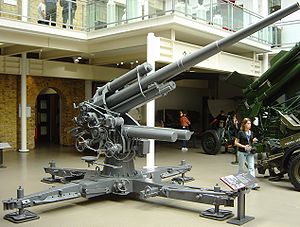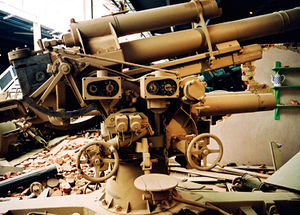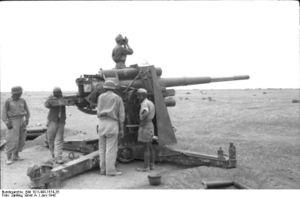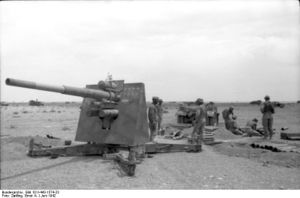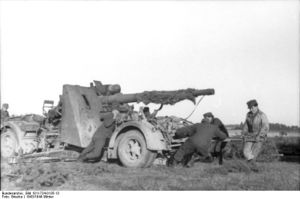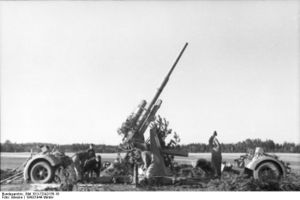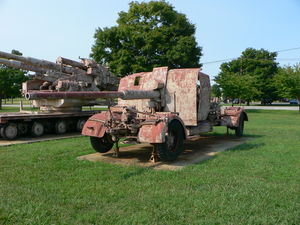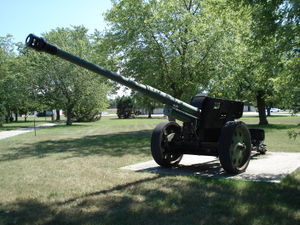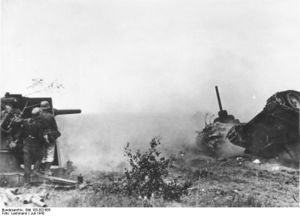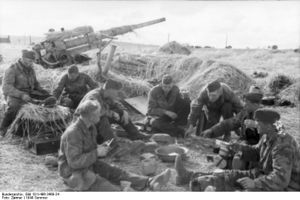8.8 cm FlaK 18/36/37/41
The 88 mm gun (eighty-eight) was a German anti-aircraft and anti-tank artillery gun from World War II. They were widely used throughout the war, and could be found on almost every battlefield, making it one of the most recognizable German weapons of the war. Developments of the original models led to a wide variety of guns.
The name applies to a series of anti-aircraft guns officially called the 8,8 cm FlaK 18, 36 or 37. FlaK is a German contraction of Flugzeugabwehr-Kanone or Flugabwehr-Kanone (hence the capital K) meaning anti-aircraft gun, the original purpose of the eighty-eight. In informal German use, the guns were universally known as the Acht-acht (8-8), a contraction of Acht-komma-acht Zentimeter (German: "8,8 cm" - comma being used as the decimal separator in German).
The name could also describe newer and more powerful models, the FlaK 41 and 43, although these were different weapons. Compared to the British QF 3.7 inch AA gun or United States 90 mm gun models, the 88 was built in very large numbers,[citation needed] and when doubled in the anti-tank role, it was mounted on a versatile base from which it could be fired without unlimbering.[citation needed]
Its success as an improvised anti-tank gun led to a separate line of guns for anti-tank use, the Panzerabwehr-Kanone (PaK) 88 (German: "anti-tank gun") and as the main armament for tanks such as the Tiger I, the 8.8 cm KwK 36, with the "KwK" abbreviation standing for Kampfwagenkanone ("fighting vehicle cannon").
Contents
[hide]Background
Most anti-aircraft guns of World War I were adaptations of existing medium-calibre weapons mounted to allow fire at higher angles. These weapons were useful, at least for deterrence, against the vulnerable and slow-moving aircraft of World War I. But when the performance of aircraft increased during the inter-war period, the usefulness of early AA guns decreased dramatically. They could not reach the higher altitudes at which new aircraft could fly, often flying over 6,000 metres (20,000 ft), nor could they fire rapidly enough to be effective against fast aircraft. Many military planners concluded that anti-aircraft artillery would no longer be effective, and only limited development was carried out by most countries. The exceptions were Germany, Britain and France, Sweden and later the USA and USSR, China, Japan, Spain, Czechoslovakia, Norway and Canada.
German planners instead developed more powerful guns with high muzzle velocity to reach high altitude, and much faster rates of fire. Since Germany had been forbidden to produce new weapons of almost every sort after World War I, the German Krupp company developed the new guns in partnership with Bofors of Sweden. The original design that led to the 88 was a 75 mm model. During the prototype phase, the army asked for a gun with considerably greater capability than the 75. The designers started over, using another common German calibre, 88 mm.
FlaK 18, 36 and 37
- REDIRECT Template:Refimprove section
Prototype 88s were first produced in 1928. These early models, the FlaK 18, used a single-piece barrel with a length of 56 calibres, leading to the commonly-seen designation 88/L56.
The FlaK 18 was mounted on a cruciform gun carriage that allowed fire in all directions, as opposed to split-trail designs, which allowed fire within a relatively narrow arc only. This makes sense given its anti-aircraft role.[clarification needed] The two "side" members of the carriage could be quickly folded up, allowing the gun to be lifted onto two wheeled chassis for high-speed towing. The weight of the gun meant that only large vehicles could move it, and the SdKfz 7 half-track became a common prime mover. A simple to operate "semi-automatic" loading system ejected fired shells, allowing it to be reloaded by simply inserting a new shell into a tray. The gun would then fire, recoil, and, during the return stroke, the empty casing would be thrown backward by levers, and a cam would engage and recock the gun. This resulted in firing rates of 15 to 20 rounds a minute, which was better than similar weapons of the era.[citation needed] High explosive ammunition was used against aircraft and personnel, and armour-piercing and high-explosive anti-tank against tanks and other armoured vehicles.
Widespread production started with the Nazi rise to power in 1933, and the FlaK 18 was available in small numbers when Germany intervened in the Spanish Civil War. It quickly proved to be the best anti-aircraft weapon then available. Further, the high muzzle velocity and large calibre made it an excellent long-range anti-vehicle weapon. This experience also demonstrated a number of minor problems and potential improvement opportunities.
Many of these were incorporated into the FlaK 36, which had a two-piece barrel for easier replacement of worn liners, and a new, but heavier, trailer that allowed it to be set up much more quickly, simply dropping the base while still mounted on the wheels. This made it much more suitable for fast-moving operations, the basic concept of the blitzkrieg. FlaK 36s were often fitted with an armoured shield that provided limited protection for the gunners.
The eighty-eight was used in two roles: as a mobile heavy anti-aircraft gun, and in a more static role for home defence. In this latter role the guns were arranged into batteries, groups of four directed by a single controller, and were moved only rarely. Targeting indicators were attached from the central controller to each FlaK allowing for coordinated fire. Indeed, with the automatic loading system, the gun layers' job would keep the gun barrel trained on the target area based on the signals from the controller. The loaders would keep the FlaK fed with live ammunition which would fire immediately upon insertion—all while the gun layer aimed the weapon according to the data.
The later FlaK 37, included updated instrumentation to allow the gun layers to follow directions from the single director more easily. The parts of the various versions of the guns were interchangeable, and it was not uncommon for various parts to be "mixed and matched" on a particular example. Some sources mistakenly cite that the FlaK 37 was not equipped for anti-armour purposes. The fact is all 8.8 cm FlaKs were capable of the dual role.[citation needed]
During the initial phases of the Battle of France, when the French and British counter-attacked, the eighty-eight was pressed into service[citation needed] against their heavily armored tanks such as the Char B1 bis and Matilda II, whose frontal armour could not be penetrated by the light anti-tank guns then available. Anti-tank usage became even more common during battles in North Africa and the Soviet Union. The 88 was powerful enough to penetrate over 150 mm of armour at ranges of 2 km or more, making it an unparalleled anti-tank weapon during the early war, and still formidable against all but the heaviest tanks at the end of the war. It was arguably most effective in the flat and open terrains of the North African campaign and the Eastern Front.
By August 1944, there were 10,704 FlaK 18, 36 and 37 guns in service. Owing to the increase in U.S. and British bombing raids during 1943 and 1944, the majority of these guns were used in their original anti-aircraft role, now complemented with the formidable 12.8 cm FlaK 40 and 10.5 cm FlaK 39. There were complaints that, due to the apparent ineffectiveness of anti-aircraft defenses as a whole, the guns should be transferred from air defense units to anti-tank duties, but this politically unpopular move was never made.
FlaK 41
The altitude problems were not unknown to their operators, and as early as 1939 the Luftwaffe, now in charge of anti-aircraft defences instead of the army, asked for newer weapons with even better performance. Rheinmetall responded with a new 88 mm L/71 design with a longer cartridge. It fired a 9.4-kilogram (20 lb) shell at a muzzle velocity of 1000 m/s (3,280 ft/s), giving it an effective ceiling of 11,300 meters (37,073 ft) (maximum was 15,000 meters (49,213 ft)). It also featured a lower silhouette on its turntable mounting than did the 8.8-cm FlaK 18/36/37 on its pedestal mounting. Because of the high cost and complexity of this FlaK gun, the Germans manufactured relatively few of them (556 in all) and, in February 1944, fielded only 279. Improvements in reloading further raised the firing rate, with 20 to 25 rounds a minute being quoted. Two types of gun barrel were used, with three or four sections. Krupp's proposal was the 8.8 cm Gerät 42, but it was not accepted for production as an anti-aircraft gun. However, Krupp continued development, resulting in the dreaded PaK 43 anti-tank gun.
The FlaK 41 had the disadvantage of complexity, and was prone to problems with ammunition, cases often jamming on extraction. The first guns produced were used in Tunisia, but because of problems in service they were afterwards used almost exclusively in Germany where they could be properly maintained and serviced. Only 157 FlaK 41 guns were in use as of August 1944, and 318 in January 1945. A final adaptation, known as the FlaK 37/41, mounted the FlaK 41 on the FlaK 37 carriage, but only 13 were produced.
Production numbers
| 1939 | 1940 | 1941 | 1942 | 1943 | 1944 | 1945 | Total | |
|---|---|---|---|---|---|---|---|---|
| Army | 0 | 0 | 126 | 176 | 296 | 549 | 23 | 1,170 |
| Luftwaffe | 183 | 1,130 | 1,872 | 2,876 | 4,416 | 5,933 | 715 | 17,125 |
| Total | 183 | 1,130 | 1,998 | 3,052 | 4,712 | 6,482 | 738 | 18,295 |
PaK 43 and KwK 43
A dedicated anti-tank gun, the 8.8 cm PaK 43 was developed from Krupp's Gerät 42, mentioned above. This used a new cruciform mount with the gun much closer to the ground, making it far easier to hide and harder to hit. It was also provided with a much stronger and more angled armour shield to provide better protection. The standard armament of the Tiger II, the KwK 43 tank gun, was essentially the PaK 43 externally modified to fit into a turret. There were also self-propelled versions of the gun, including the Nashorn and Jagdpanther tank destroyers. All versions were able to penetrate about 200 mm of armour at 1,000 m, allowing it to defeat the armor of any contemporary tank.
Comparison to other anti-aircraft guns
The 88 was not as powerful as its Italian or Allied counterparts. In the anti-aircraft role it fired a 9.2 kilogram (20 lb) shell at a muzzle velocity of 790 m/s (2,600 ft/s) to an effective ceiling of 7,900 meters (26,000 ft) (at maximum 10,600 meters (35,000 ft)). Although this was useful during the U.S. daylight raids, which typically took place at 7,600 meters (25,000 ft), many aircraft could fly higher than its maximum effective ceiling. In comparison, the British 3.7-inch (94 mm) Mark 3 fired a 13 kilograms (29 lb) projectile at 790 m/s (2,600 ft/s) to an effective ceiling of 10,600 meters (35,000 ft), and the American 90 mm Mark 1 fired a 10 kilograms (22 lb) shell at 820 m/s (2,700 ft/s) to the same height, while the Italian Cannone da 90/53 fired a 10.33 kg projectile at 830 m/s to an effective ceiling of 12,000 meters (39,000 ft). The Allied weapons also had the advantage of a higher rate of fire, a side-effect of their automated fuse-setters that raised the rate of fire to about 20 rpm, as opposed to the original 88 which could generally reach only 15 rpm in the anti-aircraft role. Their capabilities were further augmented by the introduction of proximity fuses, which allowed them to remain effective even with the introduction of jet engined aircraft. On the downside, the Allies' and Italian weapons were heavier and less mobile, with the Allied weapons being almost useless in the ground-attack roles until numerous modifications were carried out.[citation needed] While the U.S. and Italian 90 mm would go on to serve as powerful anti-tank guns in some roles, they were by no means as universally deployed as tank-killers as was the German 88. One primary reason for the 88's success was due to its versatility: it was used throughout the war alternately as an anti-aircraft gun or an anti-tank weapon. Its standard anti-aircraft platform allowed gunners to depress the muzzle below horizontal, unlike most other anti-aircraft guns. During the initial stages of the war, as it was becoming increasingly clear that existing anti-tank weapons were unable to pierce the armour of heavier enemy tanks, gunners increasingly put the weapon to use against enemy tanks, a situation that was aided by the prevalence of the 88 among German forces. Thousands of 88mm guns would be produced throughout the war in various models and mounts, serving in more numerous capacity as either an anti-tank or anti-aircraft gun than its equivalents.
Combat history
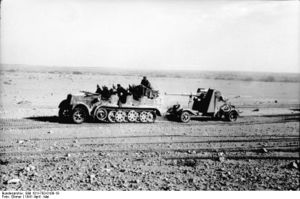
The German forces employed the 88 extensively in World War II, not only in its original role as an anti-aircraft gun, where it performed well, but also as an anti-tank gun.
The German Condor Legion made extensive use of the FlaK 88 in the Spanish Civil War, where its usefulness as an anti-tank weapon and a general artillery piece exceeded its role as an anti-aircraft weapon. Erwin Rommel also used the 88 as an anti-tank weapon, first in France and later in North Africa. His timely use of the gun to blunt the British counterattack at Arras ended any hope of a breakout from the blitzkrieg encirclement of May 1940. In Libya and Egypt, he lured British tanks into traps by baiting them with apparently retreating panzers. When the British pursued, concealed 88s picked them off at ranges far beyond those of the 2-pdr and 6-pdr guns of the British tanks. The British 8th Army eventually learned to coordinate their heavy artillery with their ground advances,[citation needed] destroying the relatively immobile 88s in their emplacements once they revealed their positions.
The weapon saw continuous use on the Soviet Front. The appearance of the outstanding T-34 shocked the German tank crews, whose 37 mm and 50 mm tank guns could only penetrate the Soviet tank's armour at extremely close range.
The less open terrain in Italy and Northern France was less suitable for the 88. The success of the 88 caused the Allies to take steps to defend against it in new tank design. Stopgap measures included adding more armour, or even using sandbags, to try to defeat the 88's projectiles. The Germans took advantage of this effective design in the armament of vehicles such as the Tiger tank and the Elefant tank destroyer (with an 88 mm Pak 43/2 anti-tank gun).
In the civil war in Yugoslavia various FlaK guns were used mainly by the naval artillery of the Yugoslav People's Army (JNA).
The FlaK 36 was briefly issued in January 1945 to the American 7th Army as captured weapons.
The 88 "family"
- 8.8 cm FlaK 18 New semi-automatic breech, high velocity gun. Entered production in Germany in 1933. Used the Sonderanhänger 201 trailer. Weight 7 tonnes. Rate of fire 15 to 20 rounds per minute. Later, fitted with a gun shield to protect the crew when engaging ground targets. Produced by Krupp.
- Mod 1938 II: Approximately 50 guns modified so a single man could adjust elevation and traverse.
- 8.8 cm FlaK 36 Entered service 1936–37. It used the redesigned trailer Sonderanhänger 202 enabling faster time to action from the move. The SdAnh 202 had twin wheels on two similar carriages. Could engage ground targets from its traveling position. Weight 7 tonnes. Rate of fire 15 to 20 rounds per minute. Produced by Krupp. Later, fitted with a shield to protect the crew when engaging ground targets.
- 8.8 cm KwK 36: Main gun of the PzKw VI Ausf. E (Tiger I) tank. Despite its designation, some classify it as a parallel development with very similar specifications rather than a derivative of the FlaK 36.
- 8.8 cm FlaK 37: An updated version of the FlaK 36, the main difference being Übertragungser 37 (a data transmission system). Produced by Krupp. Last of the versions with the shorter 571 mm cartridge case.
- 8.8 cm FlaK 41: Entered service 1943. Improved development, longer barrel and cartridge case. Fitted to the Sonderanhänger 202 as standard. Produced by Rheinmetall-Borsig.
- 8.8 cm Gerät 42: Krupp design to fill the same role as the FlaK 41; did not enter service as an anti-aircraft gun. Further development of the weapon led to the PaK 43 anti-tank gun.
- 8.8 cm PaK 43: Anti-tank model developed from Krupp's 8.8 cm Gerät 42. New gun carriage the Sonderanhänger 204. Developed by Krupp and manufactured in its different versions, including KwK 43, by at least Dortmund Hoerder-Hüttenverein, Henschel, Weserhütte and Fr. Garny. A 71 caliber barrel and a 822 mm cartridge case.
- 8.8 cm PaK 43/41: Pak 43 mounted on single axle split-trail field gun carriage produced as a stop-gap measure due to scarcity of materials. Weight 4.9 tonnes.
- 8.8 cm PaK 43/1: Pak 43 as mounted in the Nashorn tank destroyer.
- 8.8 cm PaK 43/2 Pak 43 as mounted in the Ferdinand/Elefant tank destroyer. On occasion referred to as "StuK 43/1".
- 8.8 cm PaK 43/3 and 43/4: Pak 43 as mounted in the Jagdpanther tank destroyer. Falling wedge breech block.
- 8.8 cm KwK 43: Pak 43 modified as a tank gun. Main gun of the Tiger II heavy tank. Falling wedge breech block.
See also
Notes
Cite error: Invalid <references> tag;
parameter "group" is allowed only.
<references />, or <references group="..." />References
This article includes a list of references, related reading or external links, but its sources remain unclear because it lacks inline citations. Please improve this article by introducing more precise citations. (November 2009) |
- Chant, Christopher. Artillery of World War II. London: Brown Partworks, 2001. ISBN 1840440880.
Further reading
- Gander, Terry, and Peter Chamberlain. Weapons of the Third Reich: An Encyclopedic Survey of All Small Arms, Artillery and Special Weapons of the German Land Forces 1939–1945. New York: Doubleday, 1979. ISBN 0-385-15090-3.
- Hogg, Ian V. German Artillery of World War Two. 2nd corrected edition. Mechanicsville, Penn.: Stackpole Books, 1997. ISBN 1-85367-480-X.
- Piekalkiewicz, Janusz (translated by Edward Force) (1992). The German 88 Gun in Combat: The Scourge of Allied Armor. Schiffer Military History. ISBN 978-0-887-40341-5.
External links and further reading
- All articles with unsourced statements
- Articles with unsourced statements from July 2009
- Articles with invalid date parameter in template
- Wikipedia articles needing clarification from June 2009
- Articles with unsourced statements from October 2008
- Pages with broken file links
- Articles with unsourced statements from February 2007
- Articles with unsourced statements from June 2009
- Articles with unsourced statements from December 2009
- Articles lacking in-text citations from November 2009
- All articles lacking in-text citations
- 88 mm artillery
- World War II anti-aircraft guns
- 2Fix
